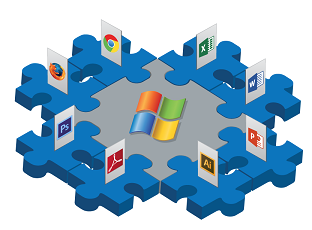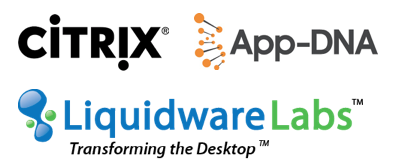I remember those days back in school when my teacher would ramble at the chalkboard explaining some new concept or theory and then my marveling at the equations she used to document the solution. Simple. Beautiful. Â I was (and am) a math nerd.

If you can measure it – you can manage it. Andy Grove @Intel
What I found most amazing was that such complex concepts and relationships could be so simply represented and expressed. It was like a new universal language that my brain totally understood – making sense of things I always assumed, but could not prove. The magic was not always in solving the equation, but rather in the realization that for the rest of my life I would be forever searching for solutions to complex problems with a tireless quest to make them simple and understandable. There is no shame in not being the smartest person in the room – however not being observant is our own fault.
Applications in the enterprise is just too awesome of a challenge to not apply this logic to. Hence, todays blog.
Assumption #1: Managing Windows, and Windows Applications, at scale, is a challenge for you.
Assumption #2: You are not a fanatical math-geek and would prefer to let software do all the work for you. (spoiler: you are in luck)
For the sake of conversation elegance I will distill my blog into two parts – Part 1 we shall call “BELOW THE OS” stuff. Part 2 (you guessed it) will be the “ABOVE THE OS ” stuff.
Part 1. – Below the OS
Anyone who claims to know how Windows truly works all the time, at scale in the enterprise, with thousands of independent applications installed and users using those in unpredictable ways, at the kernel level – is being less than truthful with you. However, software can do this quite easily. In fact Citrix’s AppDNAâ„¢ is by far the most elegant software solution that I have seen, that you can use TODAY to tame what is an incredibly complex equation with innumerable potential combinations.
Below the OS we care about things like bit level compatibility, conflicts, DLL’s, system services, com, dcom, as well as the impact different delivery methods have on each and every one of the above (in image, virtualized, streamed, layered, cloud delivered) and the myriad of potential elements that can compromise functional use of the application(s) and the system. 
If you, in any way shape or form, interact with the management of applications in your enterprise you would most likely agree that scale is also an adversary. While some applications (vendor or home grown) may be “similar” – overlooking small aspects can often have catastrophic consequences. Â With hundreds or thousands of applications in your environment – the manual math is almost impossible. So use software.
Some third-party tools can provide analysis and guidance around applications in an environment. It is rare that a piece of software can efficiently identify the challenges around application conflicts as well as operating system compatibility issues that are often invisible to the enterprise. These hidden issues can often halt basic enterprise infrastructure plans, let alone longer term decisions. Translation……The Citrix AppDNA platform plays a critical role in any enterprise application lifecycle strategy. From conflict recognition to remediation it is a stem to stern solution to help you plow through mountains of complex questions with elegance and at a great value. Other platforms do not have this. Beware of any change in application delivery methods that does not consider below the OS issues. They are like icebergs and can sink even the most well intentioned project. 
An often overlooked aspect of application and desktop compatibility analysis focuses on application performance and usage density metrics. This information is critical when prioritizing the application remediation level of effort. This “Above the OS” information might be one of the only things Citrix AppDNA does not identify. The good news is that Liquidware Labs Stratusphere UX specializes in those kinds of metrics.
Part 2. – Above the OS
So, now that we can mutually agree that applications interact with themselves and the OS in hyper-complex ways – lets add another variable that fluctuates in re al time = end user usage of the applications. This is the “above the OS” dimension. This polynomial result is almost comical to try to calculate manually because of one simple thing – human nature. Users work flows (while common) are unique, unpredictable, volatile, and abusive (why not have 44 tabs open in Chrome ;).
al time = end user usage of the applications. This is the “above the OS” dimension. This polynomial result is almost comical to try to calculate manually because of one simple thing – human nature. Users work flows (while common) are unique, unpredictable, volatile, and abusive (why not have 44 tabs open in Chrome ;).
I have yet to see a CIO or Windows Administrator – when given the StratusphereUXâ„¢ report of application usage within their enterprise say “yep  – we totally knew that“.  Never happens. Ever. What is closer to the truth is something like “wow, so we own, patch, maintain, and deliver 4,000 copies of application X and only 400 users have used it in the past 30 days and then only 109 concurrently ?” Yep. Now, this is not a mistake on the part of application administrators – its just the stain of legacy models and solutions….worst case IT I like to call it (user might need something, so give it to them just in case). With advanced application layering solutions like FlexAppâ„¢ you now have new options never available before.
So, lets commit to looking above the OS – at what our users are actually using, when they use them, how they use them, in what amount and frequency. And again, this is not a manual process – we are going to let software (StratusphereUXâ„¢) look at thousands of apps across thousands of users – instantly. 
The combination of Above the OS and Below the OS visibility – at your fingertips with a few clicks is virtually indistinguishable from magic in terms of its ability to arm you with a much, much, much easier way to deal with Windows applications at scale. You will know beforehand how your applications will act – and you will know beforehand which applications need focus, remediation, optimization, and/or delivery method tweaks.
Want to understand/learn more?  Join us on May 11th where @XenAppBlog, @Citrix, and @Liquidwarelabs will share exactly how to put these concepts into practice in your organization today.
Sign up Free Here:Â https://bit.ly/LWLBoomÂ
T.Rex
CoFounder
Circa March 2016
@T_REX_VDI for rants and raves and randomness on computers, cars, physics, art








[…] Read the entire article here, I was told there would be no math !!! […]